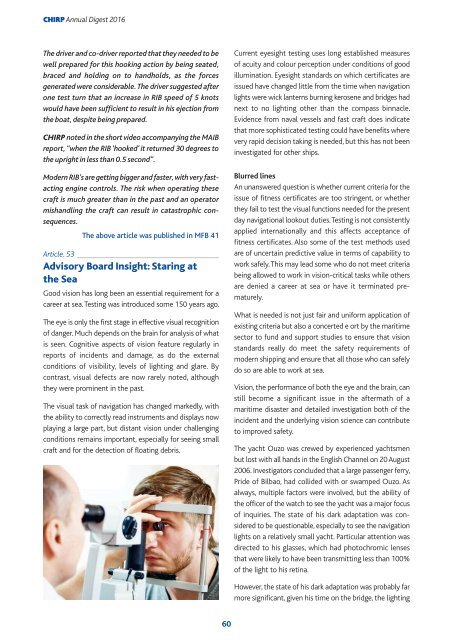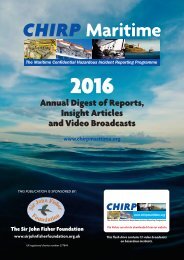CHIRP annual digest 2016 6th
You also want an ePaper? Increase the reach of your titles
YUMPU automatically turns print PDFs into web optimized ePapers that Google loves.
<strong>CHIRP</strong> Annual Digest <strong>2016</strong><br />
The driver and co-driver reported that they needed to be<br />
well prepared for this hooking action by being seated,<br />
braced and holding on to handholds, as the forces<br />
generated were considerable. The driver suggested after<br />
one test turn that an increase in RIB speed of 5 knots<br />
would have been sufficient to result in his ejection from<br />
the boat, despite being prepared.<br />
<strong>CHIRP</strong> noted in the short video accompanying the MAIB<br />
report, “when the RIB ‘hooked’ it returned 30 degrees to<br />
the upright in less than 0.5 second”.<br />
Modern RIB’s are getting bigger and faster, with very fastacting<br />
engine controls. The risk when operating these<br />
craft is much greater than in the past and an operator<br />
mishandling the craft can result in catastrophic consequences.<br />
The above article was published in MFB 41<br />
Article. 53<br />
Advisory Board Insight: Staring at<br />
the Sea<br />
Good vision has long been an essential requirement for a<br />
career at sea. Testing was introduced some 150 years ago.<br />
The eye is only the first stage in effective visual recognition<br />
of danger. Much depends on the brain for analysis of what<br />
is seen. Cognitive aspects of vision feature regularly in<br />
reports of incidents and damage, as do the external<br />
conditions of visibility, levels of lighting and glare. By<br />
contrast, visual defects are now rarely noted, although<br />
they were prominent in the past.<br />
The visual task of navigation has changed markedly, with<br />
the ability to correctly read instruments and displays now<br />
playing a large part, but distant vision under challenging<br />
conditions remains important, especially for seeing small<br />
craft and for the detection of floating debris.<br />
Current eyesight testing uses long established measures<br />
of acuity and colour perception under conditions of good<br />
illumination. Eyesight standards on which certificates are<br />
issued have changed little from the time when navigation<br />
lights were wick lanterns burning kerosene and bridges had<br />
next to no lighting other than the compass binnacle.<br />
Evidence from naval vessels and fast craft does indicate<br />
that more sophisticated testing could have benefits where<br />
very rapid decision taking is needed, but this has not been<br />
investigated for other ships.<br />
Blurred lines<br />
An unanswered question is whether current criteria for the<br />
issue of fitness certificates are too stringent, or whether<br />
they fail to test the visual functions needed for the present<br />
day navigational lookout duties. Testing is not consistently<br />
applied internationally and this affects acceptance of<br />
fitness certificates. Also some of the test methods used<br />
are of uncertain predictive value in terms of capability to<br />
work safely. This may lead some who do not meet criteria<br />
being allowed to work in vision-critical tasks while others<br />
are denied a career at sea or have it terminated pre -<br />
maturely.<br />
What is needed is not just fair and uniform application of<br />
existing criteria but also a concerted e ort by the maritime<br />
sector to fund and support studies to ensure that vision<br />
standards really do meet the safety requirements of<br />
modern shipping and ensure that all those who can safely<br />
do so are able to work at sea.<br />
Vision, the performance of both the eye and the brain, can<br />
still become a significant issue in the aftermath of a<br />
maritime disaster and detailed investigation both of the<br />
incident and the underlying vision science can contribute<br />
to improved safety.<br />
The yacht Ouzo was crewed by experienced yachtsmen<br />
but lost with all hands in the English Channel on 20 August<br />
2006. Investigators concluded that a large passenger ferry,<br />
Pride of Bilbao, had collided with or swamped Ouzo. As<br />
always, multiple factors were involved, but the ability of<br />
the officer of the watch to see the yacht was a major focus<br />
of inquiries. The state of his dark adaptation was con -<br />
sidered to be questionable, especially to see the navigation<br />
lights on a relatively small yacht. Particular attention was<br />
directed to his glasses, which had photo chromic lenses<br />
that were likely to have been transmitting less than 100%<br />
of the light to his retina.<br />
However, the state of his dark adaptation was probably far<br />
more significant, given his time on the bridge, the lighting<br />
60



